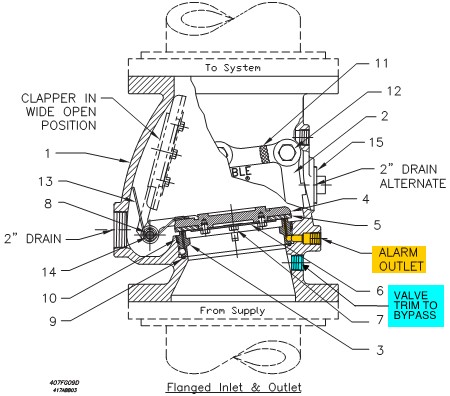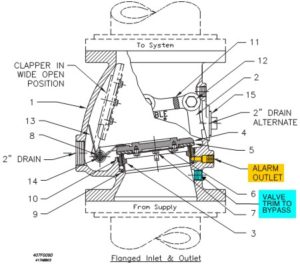
If you are reading this blog, then you are likely more aware than most of the importance of sprinkler system inspection, testing, and maintenance (ITM). One of our recent projects involved our client, a tenant, moving into a warehouse building that had sat empty and unused for some period of time. The building was nearly 20 years old and there were no records of ITM having been performed by the building owner or previous tenant. Our due diligence work for the new tenant included performance testing of each sprinkler system pressure switch-type water flow alarm device to verify that they were operating properly and sending an alarm signal to the new fire alarm control panel. Since these were existing devices, the sprinkler contractor felt that the quickest way to demonstrate their operation would be to test them using the bypass connection on the valve trim at each system riser.
NFPA 25 states that testing of pressure switch-type waterflow alarm devices shall be accomplished by operating the inspector’s test connection, with an exception provided for testing through the bypass connection if freezing weather or other circumstances prohibit the use of the inspector’s test connection. We determined that it was possible, albeit more time consuming, to use the inspector’s test connection to test all twenty of the pressure switch-type waterflow alarm devices in this building, and proceeded to accomplish the testing in this manner.
We determined that two of the twenty pressure switch-type waterflow alarm devices did not operate. For just these two devices, we tested them again, but this time using the bypass connection on the valve trim, and they operated properly. We then drained these two sprinkler systems and disassembled the alarm check valves. In each case, we discovered that the narrow alarm line port in the clapper seat had become blocked with scale from the aging pipe, which prevented operation of the pressure switch-type waterflow alarm devices on those two systems. Since the bypass connection on the valve trim is upstream of the clapper, this alarm line port is not utilized when testing through the bypass. Once the alarm line ports were unblocked, the alarm devices functioned correctly from waterflow at the inspector’s test connection.
This example shows the importance of properly testing equipment, particularly when the history of that equipment is unknown. If just the bypass connection had been used for the acceptance test, this blockage would have gone unnoticed and the waterflow switch would have failed to alarm in the event of a fire.
Check out the diagram below, courtesy of Reliable Sprinkler, for an example of an alarm check valve. You can see that the alarm outlet is fed through a small hole in the rim of the seat for the clapper.


